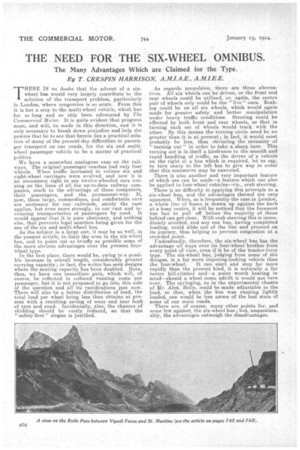THE NEED FOR THE SIX-WHEEL OMNIBUS.
Page 18

If you've noticed an error in this article please click here to report it so we can fix it.
The Many Advantages Which are Claimed for the Type, By T. CRESPIN HARRISON, A.M.I.A.E., A.M.I.E.E.
THERE IS no doubt that the advent of a sixwheel bus would very largely contribute to the solution of the transport problem, particularly in London, where congestion is so acute. From this it. is but a step to.the multi-wheel vehicle, which has for so long and so ably been advocated by The Commercial Motor. It is quite evident that progress must, and will, be made in this direction, and it is only necessary to break down prejudice ad help the powers that be to see that herein lies a practical solution of many of the present-day difficulties in passenger transport on our roads, for the six and multiwheel passenger vehicle to be a matter of practical politics.
We have a somewhat analogous case on the railways. The original passenger coaches had only four wheels. When traffic increased in volume six and eight-wheel carriages were evolved, and now it is no uncommon sight to see twelve-wheeled cars running on the lines of all the up-to-date railway companies, much to the advantage of these companies, their passengers, and the permanent-way. if, now, these large, commodious, and comfortable cars are necessary for our railroads, surely the case applies, but even more strongly, to our vast and increasing transportation of passengers by road. It would appear that it is pure obstinacy, and nothing else, that prevents legal sanction being given for the use of the six and multi-wheel bus.
As the subject is a large one, it may be as well, in the present article, to limit the area to the six-wheel bus, and to point out as briefly as possible some of the more obvious advantages over the present fourwheel type. In the first place, there would be, owing to a possible increase in overall length, considerably greater carrying capacity ; in fact, the writer has seen designs where the seating capacity has been doubled. Here, then, we have one immediate gain, which will, of course, be reflected in reduced running costs per passenger, but it is not proposed to go into this side of the question and all its ramifications just now. There will also be a, better distribution of load, the total load per wheel being less than obtains at present with a resulting saving of wear and tear both of tyre and road. Incidentally, also, the chances of skidding should be vastly reduced, so that the " safety-first " slogan is justified. As regards propulsion, there are three alternatives. All six wheels can be driven, or the front and rear wheels could be utilized, or, again, the centre pair of wheels only could be the " live " ones. Braking could be on all six wheels, which would again made for greater safety and better manipulation under heavy traffic conditions. Steering could be effected by both front and rear wheels, so that in turning each set of wheels would track with the other. By this means the turning circle need be no greater than it is at present ; in fact, it would most probably be less, thus obviating the necessity of "turning out" in order to take a sharp turn. This turning out is in itself a hindrance to the smooth and rapid handling of traffic, as the driver of a vehicle on the right of a bus which is required, let us say, to turn sharp to the left has to give way in order that this manoeuvre may be executed.
There is also another and very important feature of which use can be made—a feature which can also be applied to four-wheel vehicles—viz., crab steering.
There is no difficulty in applying this principle to a six-wheel bus, and the advantages thereof are very apparent. When, as is frequently the case in London, a whole fine of buses is drawn up against the kerb at a busy centre, it will be noticed that the foremost bus has to pull off before the majority of those behind can get clear. With crab steering this is immediately avoided, and any one bus, .having completed loading, could slide out of the line and proceed on its journey, thus helping to prevent congestion at a crowded point.
Undoubtedly, therefore, the six-wheel bus has the advantage all ways over its four-wheel brother from every point of view, even if it be of the tractor-lorry type. The six-wheel bus, judging from some of the designs, is a far more imposing-looking vehicle than
the four-wheel. It can start and stop far more rapidly than the present kind, it is naturally a far better hill-climber and—a point worth bearing in mind—should a wheel come adrift it would not turn over. The springing, as in the experimental chassis of Mr. Alex. Halle, could be made adjustable to the load, so that, when the bus was running lightly loaded, one would be less aware of the bad state of some of our main roads.
There are., of course, many other points for, and some few against, the six-wheel bus ; but, unquestionably, the advantages outweigh the disadvantages.






























